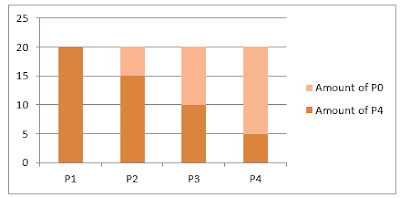Lab Report - Rouge
INTRODUCTION
Rouge is a cosmetics used to apply
color to the cheeks. Modern rouge reparations come in the forms of liquid,
cream and dry solid forms.
OBJECTIVES (POWDER ROUGE)
- To formulate dry powder rouge and cream rouge.
- To formulate cream rouge from 2 commercial
hard lipstick preparations.
- To study the factor affecting color shading in
powder and cream
- To evaluate the effect of storage condition on
the final product
MATERIALS
Basic powder formulations
|
|
Kaolin
|
16%
|
Talc
|
48%
|
Magnesium
stearate
|
6%
|
Zinc oxide
|
5%
|
Rice starch
|
10%
|
Magnesium
Carbonate
|
5%
|
Colorant
(Red101)
|
4%
|
Titanium
diaoxide q.s ad
|
100%
|
PROCEDURES
I.
Powder
rouge
a)
60g of
the basic powder formulation without colouring agent is prepared
b)
Another
60g of powder rouge is prepared containing 4% of an Insoluble red colouring
agent (P4)
c)
The 3rd
60g powder rouge is prepared by diluting the colouring agent up to 3%
d)
Step a) is repeated by using 2 different amount of colouring agents: (2%
and 1%)
Code
|
Colorant (%)
|
Amount of P4
(g)
|
Amount of P0
|
Total amount
of rouge (g)
|
P1
|
4
|
20
|
-
|
20
|
P2
|
3
|
15
|
5
|
20
|
P3
|
2
|
10
|
10
|
20
|
P4
|
1
|
5
|
15
|
20
|
RESULTS
1. Powder
rouge in the dark
Code
|
Colour separation
|
Change in colour
|
Flow properties
|
P1
|
No
|
No
|
Good
|
P2
|
No
|
No
|
Good
|
P3
|
No
|
No
|
Good
|
P4
|
No
|
No
|
Good
|
2. Powder
rouge when exposed to sunlight
Code
|
Colour separation
|
Change in colour
|
Flow properties
|
P1
|
No
|
No
|
Good
|
P2
|
No
|
No
|
Good
|
P3
|
No
|
No
|
Good
|
P4
|
No
|
No
|
Good
|
3. Powder
rouge when test on cheek
Code
|
Duration of application
|
Result
|
P1
|
6 hours
|
No irritation, smooth
|
P2
|
6 hours
|
No irritation, smooth
|
P3
|
6 hours
|
No irritation, smooth
|
P4
|
6 hours
|
No irritation, smooth
|
4. Chart
of colour shading of powder rouges
DISCUSSION
According to the Food and Drug Administration, colour additive as
defined by the regulation is any dye, pigment or other substance that can
impart colour to a food, drug, cosmetic or to the human body. Colour additive
is an important component of many products, making them attractive, appealing,
appetizing and informative.
Dyes can be water soluble or
oil soluble. Thus, solubility of dyes in powder or cream rouge is important to
give the colour effect. Water soluble dye gives crisp, transparent colour and
light, clean tints to the opaque products. Oil soluble dye gives a more uniform
and even colour compared to water soluble dyes, especially if it is used in
producing cream rouge.
From the chart of colour shading from the result, the concentration of
the colourant is the one which will determine the colour shadings of powder
rouges. This is because when the greater amount of P4 is added in the
formulation, the darker the shadings of powder rouge will be. P4 is the
formulation that has been added 4% of colourant of the total weight of
formulation meanwhile P0 is the formulation that has no colourant.
Four same amounts (20g) of powder rouges are formed by mixing different
amount of P4 and P0 respectively. The powder rouges are labeled as P1, P2, P3
and P4. P1 has 4% of colourant (20g of P4), P2 has 3% of colourant (15g of P4
mix with 5g of P0), P3 has 2% of colourant (10g of P4 mix with 10g of P0) and
P4 has 1% of colourant (5g of P4 mix with 15g P0).
Powder rouge is the most
commonly used and preferred nowadays, though in compressed one, compared to
cream rouge. There are some differences between powder rouge and cream rouge. Powder
rouge is suitable for those with oily or combination skin because powder rouge
is able to absorb grease for a matte finish. Meanwhile, the individual with a
dry skin needs to opt for cream rouge, which is more emollient in order to
minimize flaking. Powder rouge will give a more finished look and this is
perfect for contouring cheekbones. Cream rouge will give a dewy and outdoorsy
flush. Another great benefit of powder rouge is it can be used as eye shadow as
well and it can last for a day, while cream rouge can be used as lipstick due
to its creamy texture and it gives a soft, long-lasting glow, youthful
appearance.
The ingredients in the powder rouge formulation are kaolin, talc,
magnesium stearate, zinc oxide, rice starch, magnesium carbonate, colourant and
titanium dioxide. Kaolin is a natural clay-like mineral and composed of silica,
iron, magnesium, calcium, sodium, zinc and other minerals. It is a white
insoluble powder which has excellent absorbent properties which is used to draw
out impurities and toxins. It is also an anticaking agent which will helps in
preventing the powder from caking and clumping. Rice starch has the same
absorbent properties as kaolin. Talc is as a lubricant, mattes and hues the
skin. It has an antibacterial effect, hence preventing skin impurities. Magnesium
stearate as a glidant, which is a substance that helps improving the
flowability of powders, in the powder rouge formulation. Zinc oxide acts as a
bulking agent and permits it to cover the skin more thoroughly. Titanium dioxide
imparts whiteness to coloured cosmetics and personal care products that are
applied to the skin (including the eye area), nails and lips. It helps to
increase the opacity and reduce the transparency of a product formulation. It
also absorbs, reflects and scatters light (including ultraviolet radiation),
which can protect the product from deterioration.
To test the stability of products, the
powder rouges have been stored in different conditions, which are exposed to
sunlight and in dark. The criteria that has been look for are the colour
separation, change in colour and flow properties, to know is there any
differences before and after the way to store the powder rouge. After one
month, as stated in the result, there are no differences in colour separation,
colour change and flow properties, which mean that the storage of the powder
rouges either exposed to light or in dark does not results any effect. There is
no colour separation because the preparation of the rouge does not involve any
liquid substances, it was prepared in a completely dry condition from the
weighing, mixing as well as packaging. In addition, the formulation contains
titanium dioxide which absorbs, reflects and scatters light (including
ultraviolet radiation) as mention above. So, the product is protected from
deterioration. Besides, magnesium stearate which is a good glidant is also
incorporated in the formulation. Hence, the powder still has good flow
properties even after a month of storage.
However, it was only tested for one
month, thus some precautions still need to be done like avoid exposing it to
direct sunlight to make sure that the product will not be undergo any chemical
or physical changes throughout the usage before the expiring date.
CONCLUSION
Four
powder rouges have been formulated by modifying the
concentration of the colorant and are labeled as P1, P2, P3 and P4. The concentration of colourant is the one which will
determine the colour shadings of powder rouges. The greater the concentration
of the colorant, the darker the colour shadings of the rouge will be.
Meanwhile, the storage conditions are very important towards the product
stability. Exposure to sunlight may cause separation of colorant, bad flow
properties and change in colour. However, throughout this experiment, the storage
conditions do not affect the stability of the powder rouges.
REFERENCES
2.
Julie,
N. B., Arthur, L. L. & Catherine, J. B. 2003. Color Additives: FDA's
Regulatory Process and Historical Perspectives.
http://www.fda.gov/ForIndustry/ColorAdditives/RegulatoryProcessHistoricalPerspectives
http://www.fda.gov/ForIndustry/ColorAdditives/RegulatoryProcessHistoricalPerspectives
3.
Gio.
2015. Cream VS Powder Blush: Which is better?.
http://www.beautifulwithbrains.com/better-cream-powder-blush
http://www.beautifulwithbrains.com/better-cream-powder-blush
4.
Anon.
2002. Better Blush How-tos.
http://www.cosmopolitan.com/style-beauty/beauty/how-to/a107/better-blush-how-tos
http://www.cosmopolitan.com/style-beauty/beauty/how-to/a107/better-blush-how-tos



Comments
Post a Comment